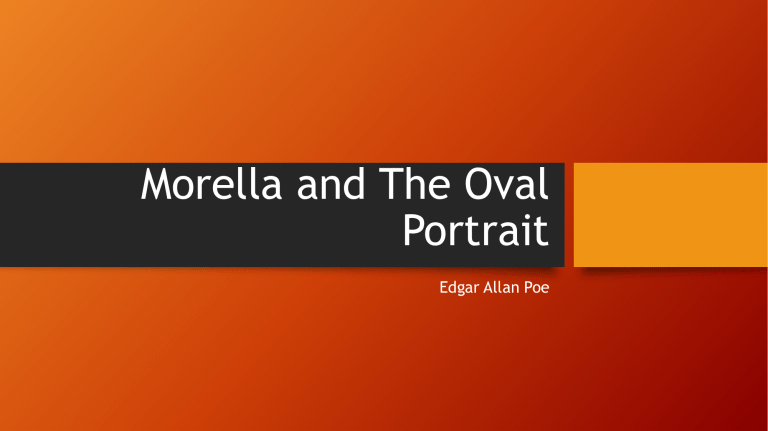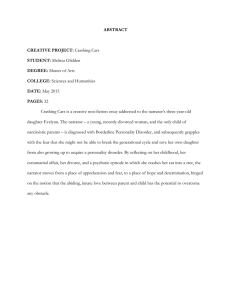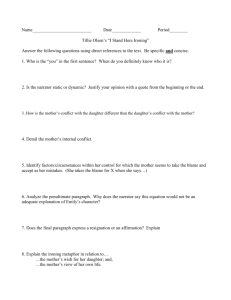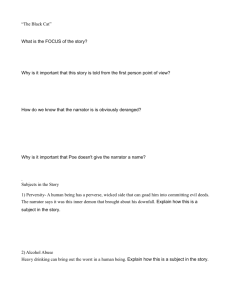Morella and The Oval Portrait
advertisement

Morella and The Oval Portrait Edgar Allan Poe Quiz Time • Who is the narrator in Edgar Allen Poe's Morella? • What name is the daughter baptized with and how does she respond? • What does the narrator find in the tomb? • Who is the woman in The Oval Portrait? • What did she hate? Morella • Published in April 1835 in the Southern Literary Messenger • Poe’s favorite short story • Originally included a 16 line poem called “Hymn” which was sung by Morella. He later removed the poem and published it separately under the title “A Catholic Hymn” • Name is based on the morel plant (black nightshade), where belladonna is derived from, and which grows in abundance in Pressburg- where Morella received her education • Falls under 2 genres: Gothic Literature and Dark Romanticism Popcorn Plot twist • You tell me what happened • First person tells me a part and so on until everyone has talked and the story is told. • No telling the ending early…. If you do we start over Major Themes • Fate of the individual after death • Horror • Jelousy • Spousal Mistreatment • Revenge • Fate or Choice Moral Theology • a branch of religious and philosophical thought that probes questions about what it means to be a sane and good person • In Morella, it is used to indicate a preference toward belief in the everlasting, immortal human soul. He draws on philosophy and religion throughout this passage in order to dramatize how Morella transcends her corporeal body and assumes a new life in a new one. • Major Philosophers include Johann Gottlieb Fichte, Friedrich Wilhelm Joseph von Schelling, and Pythagoras • The idea is that God and the universe are one and the same. When you die your soul joins a collective “consciousness” that waits until it can be reborn The Uncanny Woman • Morella is unlike most female characters to this point • She is exceptionally intelligent and strongwilled • After they marry, Morella introduces him to one of her favorite activities: studying mystical writings. Pouring over them, the narrator hopes to fathom their arcane meanings, but fails. So he submits himself to his wife’s guidance. • But she is unloved and her spirit begins to fade as she is neglected • Promises him that he will never see happiness, only sorrow when she dies. It is only here where she tells him she is pregnant and about to give birth to a daughter Private piece of Hell • The narrator could have had a marriage of comfort, but he doesn’t love anything about her except her intelligence. She eventually finds himself jealous of her abilities and unable to compete with her so he comes to despise her. • All that he could have had becomes a nightmare for him • “a forbidden spirit" arises within him as she recites strange words “from the ashes of a dead philosophy." For hours at a time, he listens to her, enjoying the lull of her musical voice. But one day her words become “tainted with terror" and a shadow falls across the narrator's soul. It is no longer a joy to listen to her; it is a horror. • “The most beautiful became the most hideous," the narrator says, “as Hinnon became Ge-Henna." • Hinnom is the valley surrounding the City of David, which was a place of Joy and solidarity. After the death of David a portion of it became Ge-Henna, which was a place where the kings of Judah would burn their children as sacrifices to a pagan god called Moloch • Rabbinic Literature refers to Ge-henna as a place the wicked go; often synonomous with Hell • “I could no longer bear the touch of her wan fingers," the narrator says, "nor the low tone of her musical language, nor the lustre of her melancholy eyes." Revenge is bittersweet • In spite of her preoccupation with the incorporeal, she still needs physical expressions of love and affection. • Deeply wounded by the narrator’s rejection of her, Morella decides to gain revenge on her death. As she grows weaker, the narrator begins to wish she would just hurry up and die. • Calling upon her knowledge of metempsychosis, she passes her soul into the body of her daughter, whom she gives birth to at the moment she dies. Her husband obviously takes his own needs at least once but it only wounds her more. • The daughter is an exact replica of her mother and grows very quickly in both physical and mental capacities The Daughter • While the narrator despised his wife, he loves his daughter beyond all reason • He remains fascinated by her growth and the traits she is portraying • The narrator becomes unsettled when the daughter turns 10. He becomes consumed with the comparison of her with Morella. He is unable to shake the feelings of dread and fear that surround him • He decides to have his daughter baptized and give her a name. • Why is this important? The ending • At the baptismal font, the clergyman asks what the child is to be called. A demon then seizes control of the causing him against his will to whisper the child's name into the ear of the clergyman: Morella. The child hears the whisper, falls onto the family’s vault, and says, “I am here." • The girl dies after speaking • When the narrator places his daughter in the vault he begins to laugh when he “lays the second where the first should be” Is he a reliable narrator? • Poe is known for choosing characters that seem perfectly normal but are actually nuttier than a fruitcake • Thoughts offered for Frank (Yes, I named him) • Morella did in fact learn how to pass her soul on, and in turn destroyed her body when the daughter was born • Frank is suicidal and having a delusion during his death • “the hemlock and the cypress overshadowed me night and day." • Socrates was forced to drink poison made from the hemlock plant. Drinking a hemlock concoction was the method of capital punishment in ancient Athens. This mode of execution was like modern "lethal injection" except that the condemned prisoner drank death rather than receiving it through a vein. Over the centuries, writers incorrectly reported that Socrates committed suicide, and hemlock became associated with self-inflicted death. In "Morella," the narrator's reference to hemlock indicates that he contemplated suicide. As for the cypress, it is a tree that has been long associated with sadness and melancholy • Frank is crazy and imagined the daughter, the death, or the whole Morella story • During the funeral rites for the daughter, Morella leaves the tomb as a vampire or zombie in order to bedevil the narrator later • What do you think happened? The Oval Portrait • Possibly Poe’s shortest piece • Published April 1842 in Graham’s Magazine under the title "Life in Death" • It included a few introductory paragraphs explaining how the narrator had been wounded, and that he had eaten opium to relieve the pain. • Poe probably excised this introduction because it was not particularly relevant, and it also gave the impression that the story was nothing more than a hallucination. • Republished in April 1845 in the Broadway Journal • Even though it is short, it served to influence Oscar Wilde’s Portrait of Dorian Grey and Nathaniel Hawthorne’s “The Birthmark” Themes • Art vs Life • Beauty as Death (actually more of a trope than a theme) • A trope is something that is reoccurring across a genre • A theme is a meaning or subject • Nature of creativity • Submissiveness • Fatal Love A lot of stuff in a tiny package and so much to question • Tale within a Tale within a Tale • The traveler • The Storybook • The artist and his wife • A nod to Anne Radcliffe, author of Gothic literature in British Literature • He has literal framed the portrait in the story • It can clearly be analyzed as a story about the uneasy relationship between life and art, embodied by the young bride and the oval portrait her artist-husband paints of her. • a warning about the danger of neglecting reality in the rush to pursue great art. As soon as the artist stops looking to reality – embodied in the story by his devoted, but increasingly weaker, wife – and becomes wrapped up in art itself, he makes a grave error. • statement about the nature of creativity – namely, that no great art was ever created without cost. After all, the oval portrait is an artistic success – it is its lifelike quality, and the artist’s triumph in having managed to capture the living essence of his subject, that first draws the narrator’s attention to it among all the other paintings. So what exactly happened to the girl? • 2 ways to read the story • The artist paints a portrait of his wife, and becomes more and more obsessed with capturing her likeness, until he ends up spending all of his time gazing at the portrait of his wife, and not looking at her. She becomes weaker and weaker because she has lost his love. She dies as he finishes. • As the artist paints her, he is stealing her beauty in an attempt to create the perfect portrayal only to find her dead as he declares that the painting is “life itself.”



